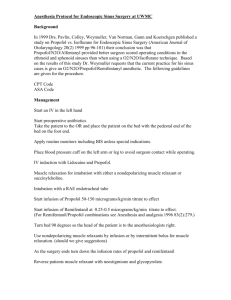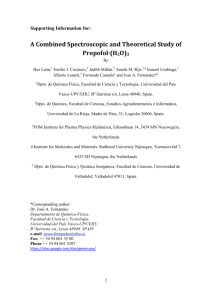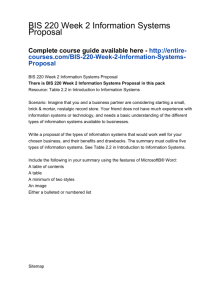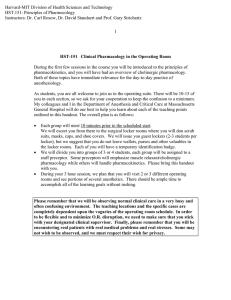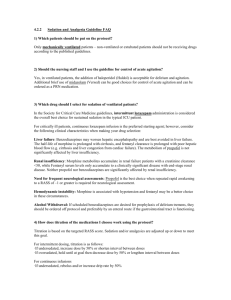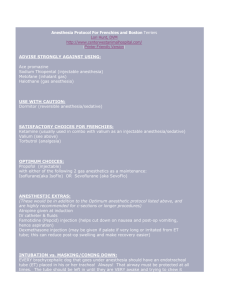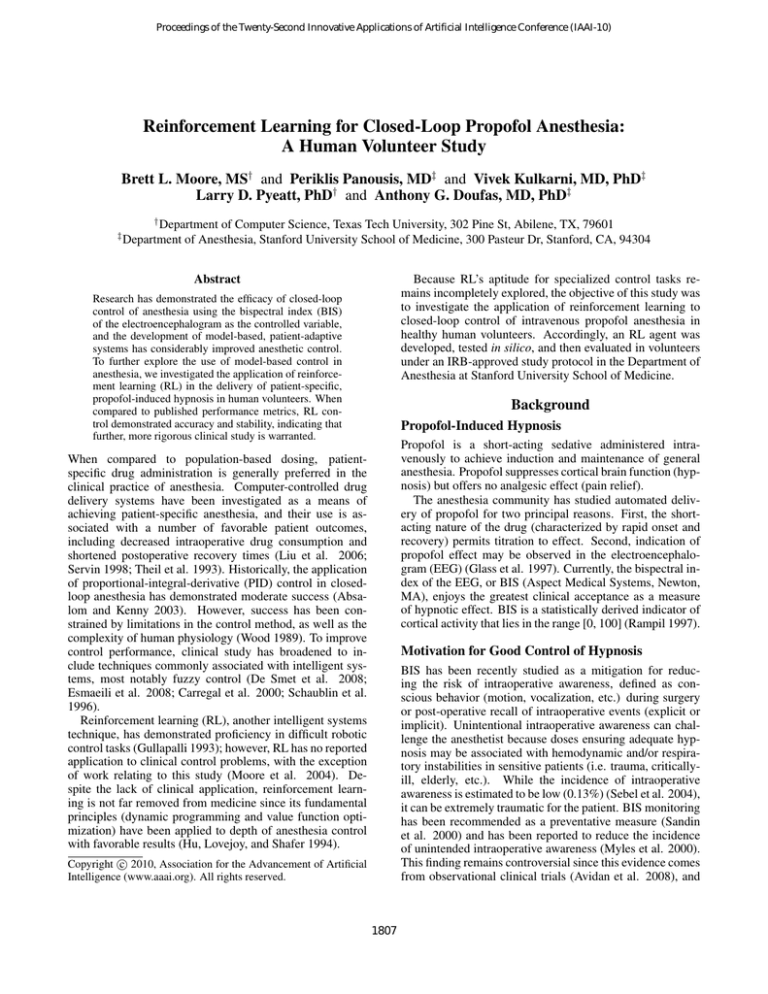
Proceedings of the Twenty-Second Innovative Applications of Artificial Intelligence Conference (IAAI-10)
Reinforcement Learning for Closed-Loop Propofol Anesthesia:
A Human Volunteer Study
Brett L. Moore, MS† and Periklis Panousis, MD‡ and Vivek Kulkarni, MD, PhD‡
Larry D. Pyeatt, PhD† and Anthony G. Doufas, MD, PhD‡
†
‡
Department of Computer Science, Texas Tech University, 302 Pine St, Abilene, TX, 79601
Department of Anesthesia, Stanford University School of Medicine, 300 Pasteur Dr, Stanford, CA, 94304
Abstract
Because RL’s aptitude for specialized control tasks remains incompletely explored, the objective of this study was
to investigate the application of reinforcement learning to
closed-loop control of intravenous propofol anesthesia in
healthy human volunteers. Accordingly, an RL agent was
developed, tested in silico, and then evaluated in volunteers
under an IRB-approved study protocol in the Department of
Anesthesia at Stanford University School of Medicine.
Research has demonstrated the efficacy of closed-loop
control of anesthesia using the bispectral index (BIS)
of the electroencephalogram as the controlled variable,
and the development of model-based, patient-adaptive
systems has considerably improved anesthetic control.
To further explore the use of model-based control in
anesthesia, we investigated the application of reinforcement learning (RL) in the delivery of patient-specific,
propofol-induced hypnosis in human volunteers. When
compared to published performance metrics, RL control demonstrated accuracy and stability, indicating that
further, more rigorous clinical study is warranted.
Background
Propofol-Induced Hypnosis
Propofol is a short-acting sedative administered intravenously to achieve induction and maintenance of general
anesthesia. Propofol suppresses cortical brain function (hypnosis) but offers no analgesic effect (pain relief).
The anesthesia community has studied automated delivery of propofol for two principal reasons. First, the shortacting nature of the drug (characterized by rapid onset and
recovery) permits titration to effect. Second, indication of
propofol effect may be observed in the electroencephalogram (EEG) (Glass et al. 1997). Currently, the bispectral index of the EEG, or BIS (Aspect Medical Systems, Newton,
MA), enjoys the greatest clinical acceptance as a measure
of hypnotic effect. BIS is a statistically derived indicator of
cortical activity that lies in the range [0, 100] (Rampil 1997).
When compared to population-based dosing, patientspecific drug administration is generally preferred in the
clinical practice of anesthesia. Computer-controlled drug
delivery systems have been investigated as a means of
achieving patient-specific anesthesia, and their use is associated with a number of favorable patient outcomes,
including decreased intraoperative drug consumption and
shortened postoperative recovery times (Liu et al. 2006;
Servin 1998; Theil et al. 1993). Historically, the application
of proportional-integral-derivative (PID) control in closedloop anesthesia has demonstrated moderate success (Absalom and Kenny 2003). However, success has been constrained by limitations in the control method, as well as the
complexity of human physiology (Wood 1989). To improve
control performance, clinical study has broadened to include techniques commonly associated with intelligent systems, most notably fuzzy control (De Smet et al. 2008;
Esmaeili et al. 2008; Carregal et al. 2000; Schaublin et al.
1996).
Reinforcement learning (RL), another intelligent systems
technique, has demonstrated proficiency in difficult robotic
control tasks (Gullapalli 1993); however, RL has no reported
application to clinical control problems, with the exception
of work relating to this study (Moore et al. 2004). Despite the lack of clinical application, reinforcement learning is not far removed from medicine since its fundamental
principles (dynamic programming and value function optimization) have been applied to depth of anesthesia control
with favorable results (Hu, Lovejoy, and Shafer 1994).
Motivation for Good Control of Hypnosis
BIS has been recently studied as a mitigation for reducing the risk of intraoperative awareness, defined as conscious behavior (motion, vocalization, etc.) during surgery
or post-operative recall of intraoperative events (explicit or
implicit). Unintentional intraoperative awareness can challenge the anesthetist because doses ensuring adequate hypnosis may be associated with hemodynamic and/or respiratory instabilities in sensitive patients (i.e. trauma, criticallyill, elderly, etc.). While the incidence of intraoperative
awareness is estimated to be low (0.13%) (Sebel et al. 2004),
it can be extremely traumatic for the patient. BIS monitoring
has been recommended as a preventative measure (Sandin
et al. 2000) and has been reported to reduce the incidence
of unintended intraoperative awareness (Myles et al. 2000).
This finding remains controversial since this evidence comes
from observational clinical trials (Avidan et al. 2008), and
c 2010, Association for the Advancement of Artificial
Copyright Intelligence (www.aaai.org). All rights reserved.
1807
Stanford University School of Medicine, consisted of fifteen, consecutively-studied, healthy volunteers.
the execution of a convincing prospective clinical trial is logistically challenging.
At first glance, the risk of intraoperative awareness implies that “deeper is better”; however, higher doses of propofol are correlated with incidences of respiratory and hemodynamic depression. Emerging research corroborates a need
for balance: Lindholm et al. report a possible causal link
between deep anesthesia (BIS < 45) and postoperative morbidity (Lindholm et al. 2009). As before, this conclusion
requires further substantiation before universal acceptance.
These opposing concerns (awareness versus toxicity), as
well as the favorable outcomes cited above, associate good
control of intraoperative anesthesia with good patient care.
Consequently, closed-loop control of propofol-induced hypnosis is well-represented in the literature (Struys et al. 2007;
2004; Absalom and Kenny 2003; Leslie, Absalom, and
Kenny 2002; Absalom, Sutcliffe, and Kenny 2002; Sakai et
al. 2000; Struys et al. 2001), but accurate and stable control
of intraoperative hypnosis remains an unsolved problem.
Agent Architecture
Agent Inputs To achieve and maintain a desired level of
hypnosis (BIStarget ), the agent first observed the volunteer’s
bispectral index (BISmeasured ) on five-second intervals, as
reported by an A-2000 BIS monitor (Aspect Medical Systems, Norwood, MA). Since BIS is an inherently noisy signal, BISmeasured was smoothed using a low-pass filter. Two
control inputs were then computed: E and ∆E. E was defined as (BISsmoothed − BIStarget ), and ∆E was defined as
the change in E over 15s, or (Et − Et−2 ).
In pilot studies, the combined effects of BIS measurement
noise and transport delay resulted in oscillatory behavior.
These confounding influences were successfully mitigated
by conditioning E and ∆E with sets of fuzzy membership
functions (Zadeh 1965). The fuzzy set membership for E
and ∆E was assessed using two sets of triangular membership functions, µN (x), µZ (x), and µP (x). The resulting
six-dimensional feature vector served as the agent’s input.
Challenges to Optimal Control of Hypnosis
Existing closed-loop drug delivery systems are typically
based on population models of drug effect (Vuyk et al.
1995), making them ill-equipped for accurate drug delivery in the individual. Age, gender, and ethnicity, as well
as disease and surgical intervention (Schnider et al. 1998;
Barvais et al. 1996), are known to affect a patient’s response to propofol infusion. Control of propofol-induced
hypnosis is also complicated by delays in action and effect (transport delay in control literature). The delays
are variable, hysteretic, and demonstrate flow rate dependence (Struys et al. 2007; Pilge et al. 2006). Furthermore, environmental conditions can influence patient response; for example, routine surgical events (incision, manipulation, etc) challenge good control (Röpcke et al. 2001;
Ausems et al. 1986).
Agent Actions The agent delivered propofol via a catheter
placed in the antecubital vein (elbow) using a precision syringe pump (Pump 33, Harvard Apparatus, Holliston, MA).
During control, the agent could select an infusion rate from
a discrete set ranging from 0.0–6.0 ml/min. Once a rate was
selected, the action remained in effect for five seconds. The
agent lacked the ability to directly reduce propofol concentrations in the patient, resulting in a condition of asymmetric
control.
Knowledge Representation During the control process,
the RL agent is expected to observe the patient’s state, and
then select the appropriate propofol dose from its control
policy. To learn the optimal control policy, the agent accumulated its experience in value functions, or mathematical
descriptions of the utility of patient states and infusion rate
selections. In RL, learning is accomplished through iterative function approximation, and value functions must be
represented in suitable form; tables, decision trees, neural
networks, and weighted polynomials have precedence in the
literature. Of these, the uniformly discretized table is favored for its ease of implementation and mathematical robustness (Baird 1995).
In this study, the agent’s state observation vector consisted
of the six fuzzy membership values described previously.
The tabular value function approximator bounded each feature element to the range [0, 1], and then partitioned the
range into ten discrete bins. Thus, a table of 106 entries
was associated with each discrete infusion rate.
Reinforcement Learning
Reinforcement learning (RL) is intelligent control method
that presents a structured, mathematically robust mechanism
for goal-directed decision-making in which long-term gain
is to be maximized (Sutton and Barto 1998). Unlike supervised learning methods, no examples of desired behavior are provided during training; instead, behavior is guided
through positive or negative reinforcements. Knowledge is
gained through experimentation: actions are chosen, effects
are observed, and rewards are gained accordingly.
Methods
A study protocol was designed to evaluate the reinforcement learning (RL) agent using widely accepted measures
of closed-loop control performance. The agent was originally developed in the Department of Computer Science at
Texas Tech University. Several simulation trials, as well as
preliminary studies in human volunteers at Stanford University, were used to improve the agent’s performance and
produce a clinically suitable controller. The final clinical
evaluation, conducted in the Department of Anesthesia at
Reward The agent’s objective was to achieve and maintain the selected BIS target (i.e. minimize the absolute control error |E|). Since the task lacked an explicit terminal
state, the reward function rt+1 = −|Et | was chosen.
Agent Training
Because the naive, uninformed agent can make arbitrarily
poor dosing decisions, a simulated intraoperative patient was
1808
developed for agent training. This in silico patient also
presented an advantage in its rapid simulation of hypnotic
episodes. Reinforcement learning is fundamentally a process of statistical estimation, and a large number of training
episodes were needed to achieve clinical readiness.
The principle role of this virtual patient was to model
the time-dependent effects of propofol infusion, collectively known as the pharmacokinetic and pharmacodynamic
(PK/PD) responses to propofol. (A drug’s pharmacokinetic
properties describe its distribution within the body, and pharmacodynamic attributes characterize the dose effect.)
of propofol with observed BIS, allowing the agent to generally predict propofol effect from estimated effect site concentration. Figure 2 illustrates the observations of BIS and
propofol concentration, as well as the median fit.
Modeling Propofol Effect Propofol pharmacokinetics were modeled using Schnider’s three-compartment
model (Schnider et al. 1998), which provides the central,
rapid, and slow compartments to estimate the timedependent distribution of propofol. In this model, propofol
is introduced into the central compartment via intravenous
infusion; after infusion, the drug is free to interact with the
rapid and slow compartments through first-order, gradient
driven flow. The rapid and slow compartments represent
collections of tissues with high and low propofol transport
coefficients; however, it is important to note that the model
was derived from empirical observations. As such, these
compartments may not have a direct, obvious mapping to
physiological systems.
Figure 1 illustrates the model and its transport coefficients, which vary with patient height, weight, gender, and
age. As shown, the coefficients are subscripted to indicate
direction of flow (from, to) because the coefficients may differ directionally, i.e. the central-to-slow coefficient (kcs ) is
not equal to the slow-to-central coefficient (ksc ). Metabolic
losses of propofol are represented in kc0 .
Because an infusion of propofol exhibits a 2.7 minute
time-to-peak effect in BIS (Schnider et al. 1998), a fourth effect site compartment was implemented. The resulting transport coefficient, ke0 , was assigned a value of 0.17 (Doufas
et al. 2004). The effect-site compartment is assumed to possess negligible volume; hence, effect-site interaction is assumed to be one-way.
Figure 2: The Doufas nonlinear model for propofol pharmacodynamics. Doufas et al. observed the propofol/BIS response in
eighteen young, healthy subjects. To model propofol pharmacodynamic effect in this study, a neural network function approximator
was used to fit the median dose curve (highlighted here).
Learning Algorithm Watkins’ Q-learning algorithm was
used to train the agent (Watkins 1989). Q-learning is a temporal difference learning method characterized by modelfree, off-policy learning. The algorithm is mathematically
robust (Tsitsiklas and Van Roy 1996; Dayan 1992), a property that has contributed to the method’s popularity in applied RL applications. Furthermore, this method has been
shown to work well with tabular function approximators. To
speed learning, the Q-learning algorithm was implemented
with eligibility traces (λ = 0.8) (Sutton and Barto 1998).
Training Agent training consisted of a sequence of simulated hypnosis episodes using a standardized intraoperative patient prototype (male, 21 yr, 170 cm, 75 kg). To aid
in learning a general association of propofol infusion and
patient response, the patient’s ke0 was randomly selected
[0.17 ± 25%] at the beginning of each episode. This measure, of which the agent remained unaware, influenced the
timing and magnitude of peak BIS effect as illustrated in
Figure 3. In this figure, the effect of ke0 variation in a simulated patient is shown with a bolus of propofol delivered at
t = 0 min. The bolus was allowed to distribute according to
the Schnider pharmacokinetic model under the selected ke0 .
As shown, a larger ke0 represented a more “tightly coupled”
system in which propofol was transported to the effect site
more readily, yielding a deeper level of hypnosis. For emphasis, Figure 3 highlights the minimum hypnotic levels, as
well as the times of their occurrence. While the time of peak
effect varied by approximately 25 seconds, the range in peak
effect varied by more than 20 BIS points.
To ensure adequate exploration of the state-action space,
each episode began with an exploring start in which a BIS
target was randomly selected, and random propofol quantities were assigned to the three major PK compartments. The
Infusion
Slow
kcs
ksc
Central
kcr
krc
kc0
ke0
Metabolism
Effect site
Rapid
Figure 1: Schnider’s pharmacokinetic model of propofol. The drug
is infused into the central compartment, and concentration gradients govern the subsequent transport to other compartments.
To model the hypnotic effect of propofol, a nonlinear
pharmacodynamic model was developed using previously
obtained data (Doufas et al. 2004). A three-layer perceptron network was trained to associate arterial concentrations
1809
2.58 min
2.42 min
2.83 min
ke0 = 0.1275
76.5 BIS
ke0 = 0.17
64.3 BIS
ke0 = 0.2125
54.4 BIS
Figure 4: Interaction between the agent and simulated intraoperative patient. To estimate the agent’s performance in clinical application, simulated episodes of hypnosis were performed on a
population of 1,000 randomly selected patients. A Patient Variability Module (PVM) challenged the agent with an array of static
and time-varying parameters, including variations in patient demographics, propofol sensitivity, and intraoperative events. PVM influence was not directly observable by the agent.
Figure 3: Pharmacodynamic effect of variation in ke0 . To demonstrate the individual subject variation associated with changes in
ke0 , a bolus of propofol was delivered to a simulated patient
and propofol distribution was modeled over time. For comparison, ke0 was selected at 0.17, 0.1275 (0.17 − 25%), and 0.2125
(0.17 + 25%). The points of peak BIS effect and their associated
times are highlighted.
agent was then permitted to interact with the patient and accumulate reinforcements. After 1,000 action choices (5,000
simulated seconds), the episode was concluded, and a new
one begun.
Training began with a step-size parameter α = 0.2, horizon parameter γ = 0.69, and an exploration parameter =
0.01. To assess the progress of learning, the sum of squared
difference (SSD) was computed between intermediate control polices. When the SSD metric fell below a small threshold, α was halved, and learning resumed. This procedure
continued until α = 10−5 . In total, training required 5×107
episodes and approximately one week of CPU time on a contemporary desktop computer.
Performance Evaluation
In silico Control Policy Evaluation
where i identifies a subject, and j iterates over the set of PE
measurements for a subject. Median absolute performance
(MDAPE) error reflects the accuracy of the controller in a
subject:
The steady-state control performance was evaluated using
the four metrics of Varvel et al. (Varvel, Donoho, and Shafer
1992), which comprise the standard performance measures
in closed-loop infusion control. These metrics build upon
the instantaneous performance error (PE):
(2)
BISmeasured − BIStarget
· 100
BIStarget
The median performance error (MDPE) indicates the control
bias observed in a single patient and is computed as:
(3)
Prior to clinical application, the agent was evaluated in simulation. To assess the fitness of the candidate control policy, a Patient Variability Model (PVM) was constructed to
challenge the controller with individualized patients (Figure 4). The PVM modeled both PK and PD variation: the
PKPVM component modeled changes in ke0 as described
previously (see Figure 3), while the PDPVM block modeled
changes in propofol sensitivity (∆BISP V M ) as a sum of
time-dependent and time-independent parameters (Moore,
Pyeatt, and Doufas 2009). PVM influence can be summarized as:
(1)
PE =
(4)
M DP Ei = median (P Eij )
M DAP Ei = median (|P Eij |)
j = 1...N
j = 1...N
Wobble measures the intra-subject variability in performance error:
(5) W obblei = median (|P Eij − M DP Ei |) j = 1 . . . N
Divergence is defined as the slope of the regression line computed through the observed MDAPE measurements. Positive values indicate an increasing difference in measured and
target values; a negative divergence indicates more stable
control.
In addition to the Varvel metrics, recent studies have
computed the Controlled metric, the percentage of measurements in which the observed BIS was within ± 10
BIS (Struys et al. 2004) or ± 5 BIS (De Smet et al. 2008) of
target. As an additional performance comparator, this study
also reports the root-mean-square error (RMSE) computed
for each maintenance control interval.
BISmeasured (t) = BISideal (t) + ∆BISP V M (t)
Evaluation consisted of a sequence of sedation episodes
in a population of 1,000 simulated patients possessing
randomized demographic and PVM parameters. In each
episode, the agent was tasked with achieving and maintaining propofol-induced hypnosis for 240 minutes. BIS targets
were randomly selected (without replacement) from the set
{40,50,60}. Once selected, a target remained in effect for
80 minutes.
1810
Table 2: Control Results
Table 1: Human Volunteer Demographics
Height
(cm)
174.5±9.6
N = 15
Weight
(kg)
72.2±10.0
BMI
(kg/m2 )
22.0±1.6
Age
(yr)
20.7±2.5
Duration†
MDPE‡
MDAPE‡
Wobble‡
Divergence?
RMSE§
Controlled‡
(Nmale = 11, Nf emale = 4)
Acceptance Criteria The literature does not provide
a definitive guideline for clinically suitable control of
propofol-induced hypnosis, but a survey of three contemporary studies (De Smet et al. 2008; Struys et al. 2004;
Absalom and Kenny 2003) provides some reasonable performance goals: MDPE ≤ ±5.0%, MDAPE ≤ 7.5%, Wobble ≤ 5.0%, Divergence ≤ ±0.1%/hr, Controlled ≥ 80%,
and RMSE ≤ 5.0 BIS.
BIStarget
40
30.2±5.2
1.0±5.6
7.4±3.5
6.2±2.6
< 0.001
4.5±1.7
75.6±19.5
mean ± std. dev.
†
BIStarget
60
30.1±2.5
−0.2±1.2
2.8±1.2
2.6±1.2
< 0.001
2.9±1.1
90.5±11.0
(min),
‡
(%),
?
Aggregate
60.3±5.1
0.4±3.0
5.1±1.7
4.5±1.5
< 0.001
3.7±0.9
82.9±9.6
(%/hr),
§
(BIS)
Discussion
Clinical Application After IRB approval (Stanford
School of Medicine) and informed consent, we studied
fifteen consecutively recruited healthy (BMI ≤ 25 kg/m2 ,
18-45 yr) volunteers in the operating room at Stanford
University Medical Center.
Volunteers fasted for at least six hours prior to the study
and their vital signs were monitored according to the standards of the American Society of Anesthesiologists (ASA).
After placement of the monitors (including BIS) an intravenous catheter was inserted at the elbow. The study began
when the anesthesiologist directed the RL agent to achieve
a randomly selected initial target (40 or 60). Once BIStarget
was achieved, the agent was permitted to regulate the level
of hypnosis undisturbed for 15 minutes. A mild tetanic stimulus was then administered to the volunteer’s thigh to simulate a destabilizing surgical event, and control was allowed
to continue for an additional 15 minutes. At that time, the
agent was directed to achieve the second BIStarget . Once
the volunteer had stabilized at the second target, a similar
procedure of maintenance and stimulus followed; then, the
volunteer was then allowed to recover normally from sedation.
Figure 5 illustrates one promising aspect of RL control:
patient-specific hypnosis. During each study, the data collection system computed the predicted bispectral index as
the agent controlled the volunteer’s level of hypnosis. Using the volunteer’s demographic data, the agent’s action
history, and the Schnider-Doufas PK/PD model, an estimate of propofol effect was computed on five-second intervals. By comparing predicted and observed BIS values
(Figure 5), the RL agent’s ability to compensate for model
mis-specification is evident. As shown, Volunteer A demonstrated an apparent sensitivity to propofol: the observed hypnosis level was consistently below the predicted value for
most of the 30-minute period shown. Likewise, the RL agent
compensated for an apparent propofol tolerance in Volunteer
B. In this 30-minute period, the observed BIS was consistently above the predicted value, indicating that the volunteer required more propofol than predicted. These observations suggest that the reinforcement learning process yielded
a patient-specific control policy that may be applied to a general population of volunteers.
Analysis To analyze the steady-state control performance,
automated tools identified and discarded the intervals of induction and target change. The resulting maintenance intervals were then scored using the methods applied in the in silico performance analysis (Equations 2–5). The BIStarget =
40 and BIStarget = 60 control periods were evaluated independently, then in aggregate form.
The principle limitation of this study lies in its controlled
nature: the human volunteers were healthy and resembled
those populations from which the PK/PD models were derived. Although the agent was challenged with intra- and
inter-subject variation, it did not experience the full rigor of
the intraoperative environment. Consequently, these results
may be extrapolated to surgical patients with limited fidelity.
Limitations
Future Directions
Results
Given the favorable performance in both simulation and
healthy human volunteers, it is reasonable to evaluate the
agent in intraoperative patients to further assess the clinical
utility of RL control. A study of agent performance under
the rigors of the surgical environment and varying conditions
of patient health should provide additional insight in the suitability of the technique. Likewise, it would be interesting to
further explore the agent’s capacity for patient-specific hypnosis with evaluations in patient populations lacking good
Fifteen healthy human volunteers (11 males and 4 females)
were recruited to assess the effectiveness of RL control in
closed-loop delivery of intravenous propofol anesthesia (Table 1). Table 2 summarizes the agent’s observed control
performance in delivering propofol to achieve targets of
BIStarget = 40 and 60. As shown, the average aggregate
control metrics were within the desired performance values.
1811
References
Absalom, A., and Kenny, G. 2003. Closed-loop control
of propofol anaesthesia using bispectral index(tm): performance assessment in patients receiving computer-controlled
propofol and manually controlled remifentanil infusions for
minor surgery. British Journal of Anaesthesia 90(6):737–41.
Absalom, A.; Sutcliffe, N.; and Kenny, G. 2002. Closedloop control of anesthesia using bispectral index performance assessment in patients undergoing major orthopedic surgery under combined general and regional anesthesia.
Anesthesiology 96(1):67–73.
Ausems, M.; Jr., C. H.; Stanski, D.; and Burm, A. 1986.
Plasma concentrations of alfentanil required to supplement
nitrous oxide anesthesia for general surgery. Anesthesiology
65(4):362–73.
Avidan, M.; Zhang, L.; Burnside, B.; Finkel, K.; Searleman,
A.; Selvidge, J.; Saager, L.; Turner, M.; Rao, S.; Bottros,
M.; Hantler, C.; Jacobsohn, E.; and Evers, A. 2008. Anesthesia awareness and the bispectral index. New Eng J Med
11(358):1097–1108.
Baird, L. 1995. Residual algorithms: reinforcement learning with function approximation. In Proc. 12th International
Conference on Machine Learning, 30–37. Morgan Kaufmann.
Barvais, L.; Rausin, I.; Glen, J.; Hunter, S.; D’Hulster, D.;
Cantraine, F.; and d’Hollander, A. 1996. Administration
of propofol by target-controlled infusion in patients undergoing coronary artery surgery. J Cardiothorac Vasc Anesth
10(7):877–83.
Carregal, A.; Lorenzo, A.; Taboada, J.; and Barreiro, J.
2000. Intraoperative control of mean arterial pressure and
heart rate with alfentanyl with fuzzy logic. Rev Esp Anestesiol Reanim 47(3):108–113.
Dayan, P. 1992. The convergence of TD(λ) for general λ.
Machine Learning 8:341–362.
De Smet, T.; Struys, M.; Neckebroek, M.; den Hauwe, K. V.;
Bonte, S.; and Mortier, E. 2008. The accuracy and clinical
feasibility of a new bayesian-based closed-loop control system for propofol administration using the bispectral index as
a controlled variable. Anesthesia and Analgesia 107:1200–
1210.
Doufas, A.; Bakhshandeh, M.; Bjorksten, A.; Shafer, S.; and
Sessler, D. 2004. Induction speed is not a determinant of
propofol pharmacodynamics. Anesthesiology 101:1112–21.
Esmaeili, V.; Assareh, A.; Shamsollahi, M. B.; Moradi,
M. H.; and Arefian, N. M. 2008. Estimating the depth of
anesthesia using fuzzy soft computation applied to EEG features. Intell. Data Anal. 12(4):393–407.
Glass, P.; Bloom, M.; Kearse, L.; Rosow, C.; Sebel, P.; and
Manberg, P. 1997. Bispectral analysis measures sedation
and memory effects of propofol, midazolam, isoflurane, and
alfentanil in healthy volunteers. Anesthesiology 86(4):836–
847.
Gullapalli, V. 1993. Learning control under extreme uncertainty. In Hanson, S. J.; Cowan, J. D.; and Giles, C. L.,
Volunteer A: Apparent propofol sensitivity
MDPE60 = 0.4%
Volunteer B: Apparent propofol tolerance
MDPE60 = −0.03%
Figure 5: Examples of patient-specific anesthesia. Although the
RL agent was trained using a standardized patient prototype, the
agent demonstrated good control in subjects demonstrating apparent propofol sensitivity (Volunteer A) and apparent propofol tolerance (Volunteer B).
PK/PD models (critically ill, morbidly obese, etc).
This study has also identified some areas of improvement.
First, the agent controlled hypnosis better at BIStarget = 60
(as indicated by most metrics). Since the agent’s action
choices were recorded during this study, it is anticipated that
an improved agent can be developed by incorporating the resultant volunteer responses into the training regimen.
Second, the agent’s reward structure discouraged overshoot, leading to “soft landings” averaging 12.5 minutes
at induction (not favored by time-conscious OR schedules).
Since induction and maintenance have competing goals in
time and accuracy, a more effective solution might involve
two independent, cooperative agents.
Conclusions
The RL agent demonstrated clinically suitable performance
in the closed-loop control of propofol-induced hypnosis in
healthy human volunteers. The agent achieved generalized
control that compensated for varying degrees of intra- and
inter-subject variation in propofol effect, suggesting that RL
control may be applied to populations lacking good PK/PD
models. Since the RL agent has demonstrated good control
in both simulation and controlled human volunteer studies,
the next objective is to assess agent performance in surgical
patients.
Acknowledgments The clinical portion of this study was
funded by the Department of Anesthesia, Stanford University School of Medicine. In addition, the authors would like
to thank the operating room staff for their support, as well as
Aspect Medical for providing an A-2000 BIS monitor.
1812
Sebel, P.; Bowdle, T.; Ghoneim, M.; Rampil, I.; Padilla, R.;
Gan, T.; and Domino, K. 2004. The incidence of awareness during anesthesia: A multicenter United States study.
Anesthesia and Analgesia 99:833–839.
Servin, F. 1998. TCI compared with manually controlled
infusion of propofol: a multicentre study. Anaesthesia
53(Suppl 1):82–86.
Struys, M.; De Smet, T.; GreenWald, S.; Abasalom, A.;
Bingé, S.; and Mortier, E. 2001. Closed-loop controlled
administration of propofol using bispectral analysis. Anesthesiology 95(1):6–17.
Struys, M.; De Smet, T.; Greenwald, S.; Absalom, A.;
Bingé, S.; and Mortier, E. 2004. Performance evaluation
of two published closed-loop control systems using bispectral index monitoring: a simulation study. Anesthesiology
100(3):640–7.
Struys, M.; Coppens, M.; Neve, N. D.; Mortier, E.; Doufas,
A.; Van Bocxlaer, J.; and Shafer, S. 2007. Influence of
administration rate on propofol plasma-effect site equilibration. Anesthesiology 07(3):386–396.
Sutton, R., and Barto, A. 1998. Reinforcement Learning:
An Introduction. MIT Press.
Theil, D.; 3rd, T. S.; White, W.; Goodman, D.; Glass, P.;
Bai, S.; Jacobs, J.; and Reves, J. 1993. Midazolam and
fentanyl continuous infusion anesthesia for cardiac surgery:
a comparison of computer-assisted versus manual infusion
systems. J Cardiothorac Vasc Anesth 7(3):300–6.
Tsitsiklas, J., and Van Roy, B. 1996. An analysis of temporal difference learning with function approximation. Technical Report LIDS-P-2322, Massachusetts Institute of Technology.
Varvel, J.; Donoho, D.; and Shafer, S. 1992. Measuring
the predictive performance of computer-controlled infusion
pumps. J Pharmacokinet Biopharm 20:63–94.
Vuyk, J.; Engbers, F.; Burm, A.; Vletter, A.; and Bovill,
J. 1995. Performance of computer-controlled infusion of
propofol: an evaluation of five pharmacokinetic parameter
sets. Anesth Analg 81(6):1275–1282.
Watkins, C. 1989. Learning from Delayed Rewards. PhD
dissertation, Cambridge University, Computer Science Department.
Wood, W. 1989. Variability of human drug response. Anesthesiology 71(4):631–634.
Zadeh, L. 1965. Fuzzy sets. Information and Control 8:338–
353.
eds., Advances in Neural Information Processing Systems,
volume 5, 327–334. Morgan Kaufmann, San Mateo, CA.
Hu, C.; Lovejoy, W.; and Shafer, S. 1994. Comparison of
some control strategies for three-compartment PK/PD models. Journal of Pharmacokinetics and Biopharmaceutics
22(6):525–550.
Leslie, K.; Absalom, A.; and Kenny, G. 2002. Closed loop
control of sedation for colonoscopy using the bispectral index. Anaesthesia 57(7):690–709.
Lindholm, M.; Träff, S.; Granath, F.; Greenwald, S.; Ekbom, A.; Lennmarken, C.; and Sandin, R. 2009. Mortality
within 2 years after surgery in relation to low intraoperative
bispectral index values and preexisting malignant disease.
Anesthesia and Analgesia 108(2):508–512.
Liu, N.; Chazot, T.; A, G.; A Landais, A Restoux, K. M.;
PA Laloë, B. T.; Barvais, L.; and Fischler, M. 2006. Titration
of propofol for anesthetic induction and maintenance guided
by the bispectral index: closed-loop versus manual control:
a prospective, randomized, multicenter study. Anesthesiology 104(4):686–695.
Moore, B.; Sinzinger, E.; Quasny, T.; and Pyeatt, L. 2004.
Intelligent control of closed-loop sedation in simulated ICU
patients. In FLAIRS 2004. AAAI Press.
Moore, B.; Pyeatt, L.; and Doufas, A. 2009. Fuzzy control
for closed-loop, patient-specific hypnosis in intraoperative
patients: A simulation study. In Conf Proc IEEE Eng Med
Biol Soc, volume 1.
Myles, P.; Leslie, K.; McNeil, J.; Forbes, A.; and Chan, M.
2000. Bispectral index monitoring to prevent awareness during anaesthesia: the B-Aware randomised controlled trial.
The Lancet 363(9423):1757–1763.
Pilge, S.; Zanner, R.; Schneider, G.; Blum, J.; and Kreuzer,
M. 2006. Analysis of cerebral state, bispectral, and narcotrend indices. Anesthesiology 104(3):488–494.
Rampil, I. 1997. A primer for EEG signal processing in
anesthesia. Anesthesiology 89(4):980–1002.
Röpcke, H.; Rehberg, B.; Koenen-Bergmann, M.; Bouillon, T.; Bruhn, J.; and Hoeft, A. 2001. Surgical stimulation shifts EEG concentration-response relationship of desflurane. Anesthesiology 94(3):255–113.
Sakai, T.; Matsuki, A.; White, P.; and Giesecke, A. 2000.
Use of an EEG-bispectral closed-loop delivery system for
administering propofol. Acta Anesthesiologica Scandinavica 44:1007–1010.
Sandin, R.; Enlund, G.; Samuelsson, P.; and Lennmarken,
C. 2000. Awareness during anaesthesia : a prospective case
study. The Lancet 355(9205):707–711.
Schaublin, J.; Derighetti, M.; Feigenwinter, P.; PetersenFelix, S.; and Zbinden, A. M. 1996. Fuzzy logic control
of mechanical ventilation during anaesthesia. British Journal Anaesthesia 77(5):636–41.
Schnider, T.; Minto, C.; Gambus, P.; Andresen, C.; Goodale,
D.; Shafer, S.; and Youngs, E. 1998. The influence of
method of administration and covariates on the pharmacokinetics of propofol in adult volunteers. Anesthesiology
88(5):1170–1182.
1813

